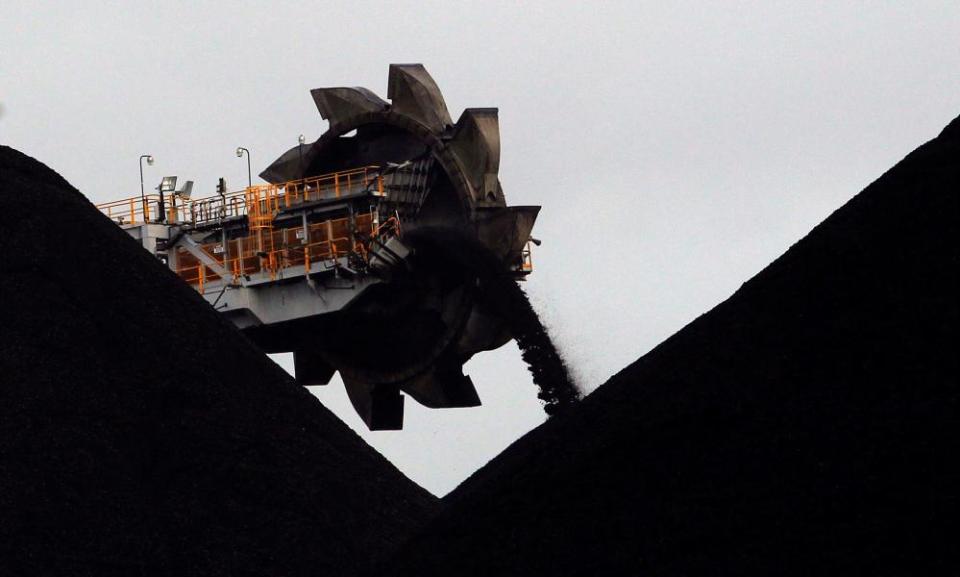Queensland mining royalties found to give 'effective subsidies' to thermal coal exporters

Queensland’s mining royalties regime gives “effective subsidies” to exporters of low-quality thermal coal, according to a new report by the Australia Institute that shows public support for an overhaul of the royalty rates.
The Queensland government and opposition have both committed to freezing mining royalties at their current level.
The new report details how the staggered system in Queensland, where low-value coal under $100 a tonne is taxed at a lower rate, acts to incentivise thermal coalmines such as Adani’s Carmichael project.
At both current and long-term predicted coal prices, thermal coalminers will pay the lowest 7% royalties rate. Those producing metallurgical coal will pay royalties in the higher brackets – 12.5% and 15%.
Related: Adani protest: French journalists' charges should be dropped, media union says
“What the staggered rate is supposed to do is mimic the mining tax and take more from coalmines when prices are high or when they’re mining particularly high-quality coal,” said Australia Institute research director Roderick Campbell.
“The effect is, however, that the lowest-quality coalmines – thermal mines like Adani’s – pay the least, while high-quality coking coalmines pay more.
“From an economic and climate perspective this is a pretty bad result, particularly without widespread carbon prices to reflect the damage costs of burning more low-quality coal.”
The report comes amid a push for authorities to better recognise the nuance between thermal coal, used to produce energy, and metallurgical (coking) coal, which is used in steelmaking and where alternatives have not yet been commercialised.
Climate activists seeking to force an energy transition have focused their attention on new thermal mining projects. Most of Queensland’s coalmines produce metallurgical coal and it accounts for 87% of the state’s coal royalties income. The public debate rarely acknowledges the distinction.
Last month, the Institute for Energy Economics and Financial Analysis called for greater differentiation, describing the types of coal as “like chalk and cheese”. It argued the state – which produces half the metallurgical coal on the world export market – could act aggressively on climate change and protect its coal royalties income by implementing policies that constrain thermal coal and instead optimise existing metallurgical coal operations.
That process would be more problematic in NSW, where the Hunter’s coalmines mainly produce thermal coal.
The Australia Institute report found that royalty rates for thermal coal remain lower in Queensland, where miners receive up to 17% discount compared to the flat rates in NSW. It calculated the effective benefit to Adani’s Carmichael project as between $12m and $30m a year.
The Queensland government is still negotiating a special royalties agreement with Adani, on top of current royalty rates, that could allow the miner to defer payments. Guardian Australia understands discussions about such a deal initially broke down about 18 months ago, due to a government requirement that Adani provide security to cover any deferred payments.
After the federal election, where Labor was trounced in several central Queensland seats, the politically-weakened state government set a deadline of 30 September to strike the agreement with Adani.
Related: Fossil fuel exports make Australia one of the worst contributors to climate crisis
The Australia Institute also conducted public polling in relation to mining royalties, which showed a large majority of people in both Queensland and NSW believed the northern state should increase royalties.
Almost half respondents in Queensland thought the state’s royalties should be increased to align with NSW. An additional 17% thought the state’s royalties should be higher than in NSW, while another 16% said they were unsure.
“Public opposition to subsidising the coal industry is not new in Queensland – the federal government’s $1b loan to Adani was vetoed by the state government which was returned in the 2016 election,” Campbell said.
“Despite this, the Queensland government is offering its own subsidised loan to Adani, through its royalty deal, and that is on top of the subsidy built into Queensland’s low royalty rates for these mines.”
A Queensland Treasury spokesman said the state’s tiered royalty structure was first established in the 2008/09 financial year and was designed to “increase the return to the Queensland community when the value of non-renewable resources increases.
“Queensland’s coal rates are based on values, not the type of coal. There have been extended periods where thermal coal has been above $100 a tonne in AUD terms.
“Marginal rates are not unusual – they are based on a view that as the value of something increases (whether that is incomes for income tax, land values for land tax, or coal values for royalty) there is a greater capacity to pay.”

 Yahoo Finance
Yahoo Finance 